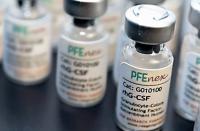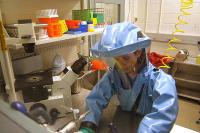-
The history of biological weapons use
Few comprehensive, definitive histories of biological warfare have been written, many events reported in the literature never happened, and few details are available about some uses of biological weapons which most certainly did occur. A new review of the literature on actual and alleged instances of biological warfare finds that the incidence of illicit biological agent use has been greater than many people may realize, even as the effects have been relatively limited.
-
-
New book details safety, security methods for biosciences sites
Recent mishaps at laboratories which mishandled potentially dangerous biological substances and the transmission of the Ebola virus in a U.S. hospital are symptoms at bioscience facilities that two Sandia National Laboratories researchers think could be prevented by implementing the practices in a new book on biorisk management. The new book, Laboratory Biorisk Management: Biosafety and Biosecurity, is the first full-length manuscript on the detailed implementation of biorisk management.
-
-
Pfenex awarded contract valued at up to $143.5 million to develop anthrax vaccine

San Diego, California-based Pfenex Inc. the other day announced it has signed a five year, cost plus fixed fee contract valued at up to $143.5 million with the Biomedical Advanced Research and Development Authority (BARDA) of the Department of Health and Human Services (HHS), for the advanced development of Px563L, a mutant recombinant protective antigen anthrax vaccine. The company says the U.S. government is looking to have a stockpile of seventy-five million doses.
-
-
Researchers carefully protect dangerous pathogens – but how secure are all their data?

Ebola, smallpox, anthrax and many others: the most dangerous microorganisms are strictly regulated in the United States. The federal government oversees use of sixty-five so-called select agents with “the potential to pose a severe threat to public, animal or plant health, or to animal or plant products.” There has never been as much research performed with these pathogens —to learn more, find cures, or create vaccines — as in the past decade. The sprawl of high containment laboratories has led to a parallel increase in individuals with access to these agents. As of January 2015, approximately 11,000 individuals were on the list. The deadly infectious agents must be kept safely under lock and key, where they can’t threaten the general population or fall into the wrong hands. But even the most physically secure research lab could be the site of a devastating data security breach. As they stand now, information security guidelines published by science regulators with regard to select agents lack the critical level of detail needed to protect data effectively.
-
-
CDC to review oversight of bioterror labs as concerns grow over lax supervision
Tom Frieden, the director of the CDC, has ordered a review of how the agency oversees and implements safety and security measures in bioterror laboratories across the country. Documents obtained through FOIA request show that dozens of labs handling the most dangerous bioterror pathogens have time and again failed to comply with key safety and security measures, but CDC inspectors allowed these labs to operate for years before offering to put them on a “performance improvement” plan. Even when inspectors identified significant violations of safety or security practices in work with “Tier 1” select agents – the deadliest of bioterror weapons — the agency only “strongly recommend[ed]” the labs stop work with the pathogens, but without mandating it.
-
-
Kosovo’s capital cuts water supplies for fear of ISIS plot to poison reservoir
Kosovo security and health authorities have cut off water supplies to tens of thousands of residents in Pristina, Kosovo’s capital, following a suspicion that ISIS followers had poisoned the city’s water supplies. The city’s water board said supply was cut early on Saturday “because of security issues” and that supplies had been tested for suspicious substances. Police sources say that security officers patrolling the Badovac reservoir saw three of the men behaving suspiciously near the reservoir, and arrested them. They were later identified as ISIS supporters. Kosovar members of ISIS recently appeared in propaganda videos, warning of attacks against targets in the Balkans, including the water supplies of major cities.
-
-
Lawmakers demand answers on labs’ handling of deadly pathogens
The leaders of the House Energy and Commerce Committee from both parties yesterday sent a letter to the Inspector General of the Department of Health and Human Services demanding answers regarding the Federal Select Agent Program (FSAP). “Select agents” is the term used by the government for viruses, bacteria, and toxins that could be used by terrorists. The committee members directed ten questions to the HHS IG in an effort to learn details about labs that have been fined or faced other enforcement actions, including suspension or revocation of their federal authorizations to work with select agents. “So far we’ve been lucky, but that luck may run out if we don’t get the system fixed,” said Representative Frank Pallone Jr. (D-New Jersey).
-
-
Safety concerns dog new Level 4 Biolab being built in the middle of Tornado Alley
The new Department of Homeland Security’s(DHS) animal pathogen-research facility, a Level 4 Biolab being built in Manhattan, Kansas and aiming to replace the aging New York’s Plum Island lab, is situated in the middle of Tornado Alley, leading researchers and security experts to question the wisdom of the decision to build it there. Why place a lab in which research is conducted on pathogens for which no cure or treatment has yet been found – fir example, foot-and-mouth disease – not only in an area known for being routinely hit by powerful tornadoes, but also in the middle of a region where most U.S. cattle is being raised?
-
-
How anthrax spores grow in cultured human tissues
Cultured human lung cells infected with a benign version of anthrax spores have yielded insights into how anthrax grows and spreads in exposed people. The study will help provide credible data for human health related to anthrax exposure and help officials better understand risks related to a potential anthrax attack. The study also defined for the first time where the spores germinate and shows that the type of cell lines and methods of culturing affect the growth rates.
-
-
No government agency oversees handling of deadly pathogens in 1,495 U.S. labs
According to the CDC, 181 “organizations or entities” in the United States are registered as working with live anthrax, and 321 in total working with live pathogens. Within these 321 entities, roughly 1,495 laboratories are accredited under the Federal Select Agent Program to work with live pathogens such as anthrax. There is no official government agency to oversee production and research of bioweapons that does not – as the CDC does — engage in its own active pathogen research. “Even one spore is a sufficient seed stock from which an amount could grow to mount a biological weapons attack,” says one expert. “The sad circumstance is that this massive effort [U.S. research on anthrax] since 2001 has dramatically increased the chances of a biological weapon attack on the U.S., precisely by distributing a highly lethal strain of the agent with no structure and no ability to record where they have gone.”
-
-
Pentagon, CDC investigating live anthrax shipping mishap
Pentagon chief Ashton Carter has announced that the Department of Defense, in collaboration with the Centers for Disease Control and Prevention (CDC), is investigating the recent accidental shipment from a U.S. Army laboratory in Utah of live bacterium anthrax samples to fifty-one facilities in eighteen states and three foreign countries. The investigators have already identified the West Desert Test Center (WDTC), the testing area for Dugway Proving Ground, as the source of the mix up.
-
-
51 labs in 17 states may have received live anthrax samples: Pentagon
Deputy Secretary of Defense Robert Work said yesterday (Wednesday) that the Pentagon may have shipped live anthrax samples to fifty-one labs in seventeen states and the District of Columbia, as well as three foreign countries. Word also said that it was likely that the numbers of labs which might have received live anthrax will go up as the Pentagon’s investigation into the shipments continues. All the samples shipped belonged to three lots, dating back to 2007, stored at the Dugway Proving Ground in Utah. CDC raises questions about the effectiveness of the method used by the Dugway lab to deactivate anthrax spores.
-
-
Pentagon accidentally ships live anthrax from Utah to labs in nine states
The U.S. Department of Defense yesterday admitted it had accidentally shipped samples of a live anthrax spores – a potential bioweapon — across nine states and to a U.S. air base in South Korea. The Pentagon revealed what it described as an “inadvertent transfer of samples containing live Bacillus anthracis” from a DoD laboratory in Dugway Proving Ground, Utah to labs in nine states. The mishap alarmed biosafety experts. “These events shouldn’t happen,” said one.
-
-
Groundbreaking for new Biosafety Level 4 lab in Kansas
Officials on Wednesday broke ground for the National Bio and Agro-Defense Facility (NBAF), a $1.25 billion animal research facility near the campus of Kansas State University in Manhattan, Kansas. NBAF will be the U.S. only Level 4 biosafety lab – a designation which means that the lab is secure enough to handle, and conduct research on, pathogens that do not currently have treatments or countermeasures. Critics argue that locating the lab on the campus of KSU — in the heart of cattle country and the middle of Tornado Alley – would not be a good idea. NBAF will replace the aging biolab in Plum Island, New York.
-
-
DHS S&T awards $834 million contract for construction of Manhattan, Kansas biolab
DHS Science and Technology Directorate (S&T) yesterday announced the award of a contract for the final phase of construction of the National Bio and Agro-Defense Facility (NBAF) being constructed in Manhattan, Kansas. The $834 million award by S&T’s procurement support partner, the Federal Law Enforcement Training Centers (FLETC), modifies the existing contract for McCarthy Mortensen NBAF Joint Venture, which was selected in 2009.
-